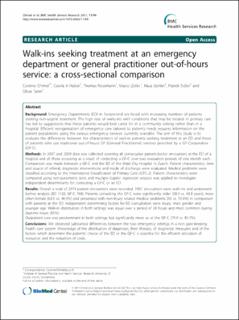Please use this identifier to cite or link to this item:
https://doi.org/10.21256/zhaw-4055Full metadata record
| DC Field | Value | Language |
|---|---|---|
| dc.contributor.author | Chmiel, Corinne | - |
| dc.contributor.author | Huber, Carola A. | - |
| dc.contributor.author | Rosemann, Thomas | - |
| dc.contributor.author | Zoller, Marco | - |
| dc.contributor.author | Eichler, Klaus | - |
| dc.contributor.author | Sidler, Patrik | - |
| dc.contributor.author | Senn, Oliver | - |
| dc.date.accessioned | 2018-11-23T10:35:54Z | - |
| dc.date.available | 2018-11-23T10:35:54Z | - |
| dc.date.issued | 2011 | - |
| dc.identifier.issn | 1472-6963 | de_CH |
| dc.identifier.uri | https://digitalcollection.zhaw.ch/handle/11475/13207 | - |
| dc.description.abstract | Background: Emergency Departments (ED) in Switzerland are faced with increasing numbers of patients seeking non-urgent treatment. The high rate of walks-ins with conditions that may be treated in primary care has led to suggestions that those patients would best cared for in a community setting rather than in a hospital. Efficient reorganization of emergency care tailored to patients needs requires information on the patient populations using the various emergency services currently available. The aim of this study is to evaluate the differences between the characteristics of walk-in patients seeking treatment at an ED and those of patients who use traditional out-of-hours GP (General Practitioner) services provided by a GP-Cooperative (GP-C). Methods: In 2007 and 2009 data was collected covering all consecutive patient-doctor encounters at the ED of a hospital and all those occurring as a result of contacting a GP-C over two evaluation periods of one month each. Comparison was made between a GP-C and the ED of the Waid City Hospital in Zurich. Patient characteristics, time and source of referral, diagnostic interventions and mode of discharge were evaluated. Medical problems were classified according to the International Classification of Primary Care (ICPC-2). Patient characteristics were compared using non-parametric tests and multiple logistic regression analysis was applied to investigate independent determinants for contacting a GP-C or an ED. Results: Overall a total of 2974 patient encounters were recorded. 1901 encounters were walk-ins and underwent further analysis (ED 1133, GP-C 768). Patients consulting the GP-C were significantly older (58.9 vs. 43.8 years), more often female (63.5 vs. 46.9%) and presented with non-injury related medical problems (93 vs. 55.6%) in comparison with patients at the ED. Independent determining factors for ED consultation were injury, male gender and younger age. Walk-in distribution in both settings was equal over a period of 24 hours and most common during daytime hours (65%). Outpatient care was predominant in both settings but significantly more so at the GP-C (79.9 vs. 85.7%). Conclusions: We observed substantial differences between the two emergency settings in a non gate-keeping health care system. Knowledge of the distribution of diagnoses, their therapy, of diagnostic measures and of the factors which determine the patients choice of the ED or the GP-C is essential for the efficient allocation of resources and the reduction of costs. | de_CH |
| dc.language.iso | en | de_CH |
| dc.publisher | BioMed Central | de_CH |
| dc.relation.ispartof | BMC Health Services Research | de_CH |
| dc.rights | http://creativecommons.org/licenses/by/2.0/ | de_CH |
| dc.subject | Primary care | de_CH |
| dc.subject | Versorgungsforschung | de_CH |
| dc.subject | Emergency care | de_CH |
| dc.subject.ddc | 362: Gesundheits- und Sozialdienste | de_CH |
| dc.title | Walk-ins seeking treatment at an emergency department or general practitioner out-of-hours service : a cross-sectional comparison | de_CH |
| dc.type | Beitrag in wissenschaftlicher Zeitschrift | de_CH |
| dcterms.type | Text | de_CH |
| zhaw.departement | School of Management and Law | de_CH |
| zhaw.organisationalunit | Winterthurer Institut für Gesundheitsökonomie (WIG) | de_CH |
| dc.identifier.doi | 10.21256/zhaw-4055 | - |
| dc.identifier.doi | 10.1186/1472-6963-11-94 | de_CH |
| zhaw.funding.eu | No | de_CH |
| zhaw.issue | 94 | de_CH |
| zhaw.originated.zhaw | Yes | de_CH |
| zhaw.publication.status | publishedVersion | de_CH |
| zhaw.volume | 11 | de_CH |
| zhaw.publication.review | Peer review (Publikation) | de_CH |
| Appears in collections: | Publikationen School of Management and Law | |
Files in This Item:
| File | Description | Size | Format | |
|---|---|---|---|---|
| Walk-ins seeking treatment_2011_SC1.1.pdf | 510.19 kB | Adobe PDF |  View/Open |
Show simple item record
Chmiel, C., Huber, C. A., Rosemann, T., Zoller, M., Eichler, K., Sidler, P., & Senn, O. (2011). Walk-ins seeking treatment at an emergency department or general practitioner out-of-hours service : a cross-sectional comparison. BMC Health Services Research, 11(94). https://doi.org/10.21256/zhaw-4055
Chmiel, C. et al. (2011) ‘Walk-ins seeking treatment at an emergency department or general practitioner out-of-hours service : a cross-sectional comparison’, BMC Health Services Research, 11(94). Available at: https://doi.org/10.21256/zhaw-4055.
C. Chmiel et al., “Walk-ins seeking treatment at an emergency department or general practitioner out-of-hours service : a cross-sectional comparison,” BMC Health Services Research, vol. 11, no. 94, 2011, doi: 10.21256/zhaw-4055.
CHMIEL, Corinne, Carola A. HUBER, Thomas ROSEMANN, Marco ZOLLER, Klaus EICHLER, Patrik SIDLER und Oliver SENN, 2011. Walk-ins seeking treatment at an emergency department or general practitioner out-of-hours service : a cross-sectional comparison. BMC Health Services Research. 2011. Bd. 11, Nr. 94. DOI 10.21256/zhaw-4055
Chmiel, Corinne, Carola A. Huber, Thomas Rosemann, Marco Zoller, Klaus Eichler, Patrik Sidler, and Oliver Senn. 2011. “Walk-Ins Seeking Treatment at an Emergency Department or General Practitioner Out-of-Hours Service : A Cross-Sectional Comparison.” BMC Health Services Research 11 (94). https://doi.org/10.21256/zhaw-4055.
Chmiel, Corinne, et al. “Walk-Ins Seeking Treatment at an Emergency Department or General Practitioner Out-of-Hours Service : A Cross-Sectional Comparison.” BMC Health Services Research, vol. 11, no. 94, 2011, https://doi.org/10.21256/zhaw-4055.
Items in DSpace are protected by copyright, with all rights reserved, unless otherwise indicated.